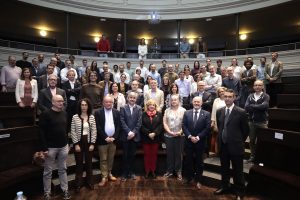
The Center for Astroparticles and High Energy Physics (CAPA), established in 2019, is taking a decisive step in its trajectory and is consolidating itself as a University Research Institute. This new status represents recognition of the excellence of its scientific work and will enable it to access more competitive funding calls, secure greater resources, and strengthen its national and international projection.
Since its creation, CAPA has stood out for its unique character within the Spanish scientific landscape, positioning itself at the forefront of research in astroparticle physics. Among its main research lines are experiments aimed at the direct detection of dark matter, such as those carried out at the Canfranc Underground Laboratory, a world-class facility, as well as projects dedicated to the detection and study of the axion, a hypothetical particle considered one of the leading candidates to make up dark matter in the universe.
On October 6, the Paraninfo of the University hosted the inauguration ceremony of the new Research Institute, which was attended by the Rector, the Vice-Rector for Planning and Strategic Development, the Director General for Science and Research, and the current and former directors of CAPA. All of them highlighted the importance of this milestone in consolidating the center’s leadership and strengthening collaboration among cutting-edge research groups, both nationally and internationally.
With this transformation, CAPA begins a new stage in which it aims to continue generating high-quality knowledge, promoting technological transfer, and contributing to answering some of the great questions of modern physics regarding the nature of the universe.
Press release issued by the Scientific Culture Unit (UCC) of the University of Zaragoza (Unizar).
Featured in El Periódico de Aragón, Heraldo de Aragón, and Aragón Digital.
Also covered by AragónTV (Instagram Reel)
